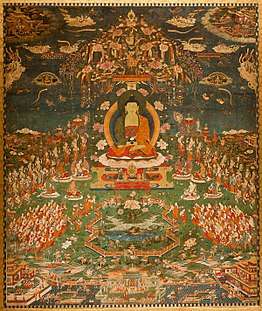Amitayurdhyana Sutra
| Part of a series on |
| Mahāyāna Buddhism |
|---|
 |
|
Transmission |
|
Teachings |
|
Mahāyāna schools |
|
|
The Amitāyurdhyāna Sūtra (Sanskrit; traditional Chinese: 佛說觀無量壽佛經) is a Mahayana sutra in Pure Land Buddhism, a branch of Mahāyāna Buddhism. It is one of the three principle Pure Land sutras along with the Infinite Life Sutra and the Amitabha Sutra. Amitāyus is another name for the Buddha Amitābha, the preeminent figure in Pure Land Buddhism, and this sūtra focuses mainly on meditations involving complex visualization. This is reflected in the name of the sūtra, which translates to the "Amitāyus Meditation Sūtra."
It is generally considered by modern scholarship to be apocryphal, a composition originally written in Chinese.[1][2][3] No Sanskrit original has been discovered and the Sanskrit name and Sanskrit versions would thus be reverse translations.[4]:10 According to Paul Williams, a more accurate Sanskrit title for this text would be Amitāyurbuddhānusmṛti Sūtra, meaning "Amitāyus Buddha-mindfulness Sūtra."[5]
Basic Outline of the Sutra
Preliminary matters
The text begins with a story where a prince named Ajatashatru was enticed by the villain Devadatta to murder his father, King Bimbisara, in order to ascend the throne. Ajatashatru kills his father, and nearly kills his mother, Queen Vaidehi, but after advice from his other ministers, he relented and threw his mother in prison.
Lamenting her fate, Queen Vaidehi prays to Gautama Buddha for help, and he is able to visit her. Vaidehi expresses her wish to be born in Amitābha's pure land. Shakyamuni smiles, emitting light from his mouth, and goes on to tell Vaidehi how to be reborn in the Pure Land. The Buddha tells her that although she is in prison, she could still obtain liberation through the practices of Amitābha. The Buddha goes on to describe Amitābha and how one could obtain rebirth in his land of Sukhavati.[6]
This tale references historical incidents of the Haryanka dynasty of Magadha, India, and the religious tension between Gautama Buddha and his brother-in-law, Devadatta.
Attaining birth in the Pure Land
Shakyamuni explains the importance of performing certain meritorious acts in order to be reborn in the Pure Land. He then goes on to teach Vaidehi how to visualize the Pure Land, to further her efforts in attaining rebirth there. Shakyamuni describes thirteen "contemplations," or mental visualization exercises, that are to be followed in order. By deeply contemplating various aspects of the Pure Land and attempting to visualize them in detail, the aspirant draws closer to the Pure Land.
The thirteen contemplations are described in order as follows:[7]
- Contemplation of the setting sun
- Contemplation of an expanse of water
- Contemplation of the ground in the pure land
- Contemplation of trees in the pure land
- Contemplation of ponds in the pure land
- Contemplation of various objects in the pure land
- Contemplation of the lotus-throne of the Buddha
- Contemplation of the image of Amitābha
- Contemplation of Amitābha himself
- Contemplation of Avalokiteśvara
- Contemplation of Mahasthamaprapta
- Contemplation of the aspirants to the pure land
- Contemplation of Amitābha and the two bodhisattvas
Nine levels of birth
In the final part of the sutra, Gautama Buddha discusses the nine levels into which those born into the Pure Land are categorized. The levels are ranked from highest to lowest as follows:[8]
- The highest level of the highest grade
- The middle level of the highest grade
- The lowest level of the highest grade
- The highest level of the middle grade
- The middle level of the middle grade
- The lowest level of the middle grade
- The highest level of the lowest grade
- The middle level of the lowest grade
- The lowest level of the lowest grade
According to the Buddha, all nine grades of human beings can achieve rebirth into the Pure Land if they contemplate Amitābha or at least call on his name. This is similar to the 48 vows made by Amitābha, according to the Infinite Life Sutra, which includes the Primal Vow.
Conclusion
The sutra ends with a short section describing the benefits gained by those who listened to these words of the Buddha. Vaidehi experienced "great awakening with clarity of mind and reached the insight into the non-arising of all dharmas," while her five hundred female attendants and "innumerable devas" also awakened aspiration for the highest enlightenment. Shakyamuni names the sutra, mentions benefits connected with the name of Amitabha Buddha, and exhorts all to hold the words of the sutra in their minds. Shakyamuni then returns through the air to Vulture Peak.
See also
- Longer Sukhāvatīvyūha Sūtra (Infinite Life Sutra)
- Shorter Sukhāvatīvyūha Sūtra (Amitabha Sutra)
- Pure Land Buddhism
- Sukhavati
- Amitābha
- Jōdo-shū
- Jōdo Shinshū
- Sutra
- Chinese Buddhism
Notes
- ↑ Silk 1997, pp. 181ff.
- ↑ Muller 1998, p. 68.
- ↑ Fujita, "The Textual Origins of the Kuan Wu-liang-shou ching: A Canonical Scripture of Pure Land Buddhism", in Buswell, Robert E.; ed. (1990). Chinese Buddhist Apocrypha, Honolulu: University of Hawaii Press, ISBN 0585349630
- ↑ "Amitayurdhyana Sutra" in Keown, Damien (2003). A dictionary of Buddhism. [Oxford]: Oxford University Press. pp. 10–11. ISBN 9780191579172.
- ↑ Williams, Paul. Mahayana Buddhism: The Doctrinal Foundations, 2nd edition. Routledge, 2009, p. 239
- ↑ Hisao Inagaki, Harold Stewart (transl.): The Three Pure Land Sutras, Berkeley: Numata Center for Buddhist Translation and Research 2003, p. XVIII. ISBN 1-886439-18-4
- ↑ Hisao Inagaki, Harold Stewart (transl.): The Three Pure Land Sutras, Berkeley: Numata Center for Buddhist Translation and Research 2003, p. XIX. ISBN 1-886439-18-4
- ↑ Hisao Inagaki, Harold Stewart (transl.): The Three Pure Land Sutras, Berkeley: Numata Center for Buddhist Translation and Research 2003, pp. XIX-XXI. ISBN 1-886439-18-4
- Silk, Jonathan A. (April 1997). "The Composition of the "Guanwuliangshoufo-jing": Some Buddhist and Jaina Parallels to its Narrative Frame". 25 (2). Journal of Indian Philosophy: 181–256. JSTOR 23448579.
Further reading
- Muller, Charles (1998). "East Asian Apocryphal Scriptures: Their Origin and Role in the Development of Sinitic Buddhism". Bulletin of Toyo Gakuen University. 6: 63–76.
- Hisao Inagaki, Harold Stewart (transl.): The Three Pure Land Sutras, Berkeley: Numata Center for Buddhist Translation and Research 2003. ISBN 1-886439-18-4 PDF retrieved 2013/07/28
- Pas, Julian F. (1974). Shan-tao's Interpretation of the Meditative Vision of Buddha Amitāyus, History of Religions 14 (2), 96-116 – via JSTOR (subscription required)
- Takakusu, J. (trans.), Friedrich Max Müller, ed.: Amitayurdhyana Sutra. In: The Sacred Books of the East, Volume XLIX: Buddhist Mahāyāna Texts, Part II. Oxford: Clarendon Press, 1894 ISBN 1-60206-381-8 Internet Archive
- Tanaka, Kenneth K. 1990. The Dawn of Chinese Pure Land Buddhist Doctrine: Jìngyǐng Huìyuán's Commentary on the Visualization Sūtra. Albany: State University of New York Press.
External links
- The Contemplation Sutra, translated into English by J. Takakusu
- English translation of the Contemplation Sutra
- The Taima Mandala Image of the Pure Land from a medieval Japanese scroll, based on the descriptions found in the Contemplation Sutra. This site offers explanations in English of the various motifs of the scroll.
